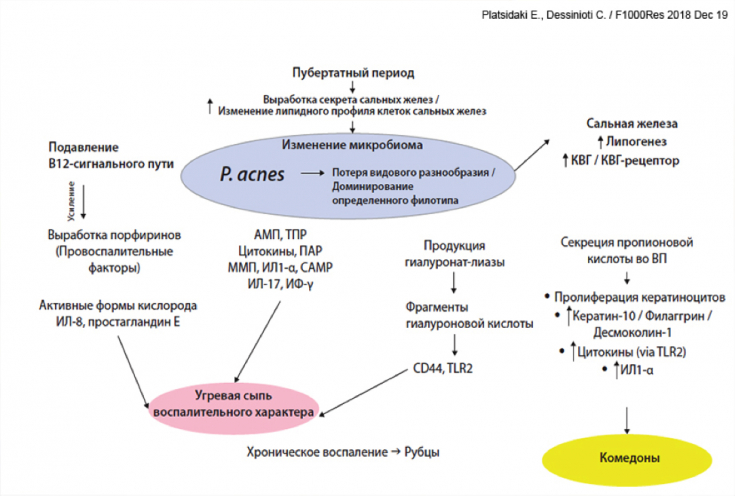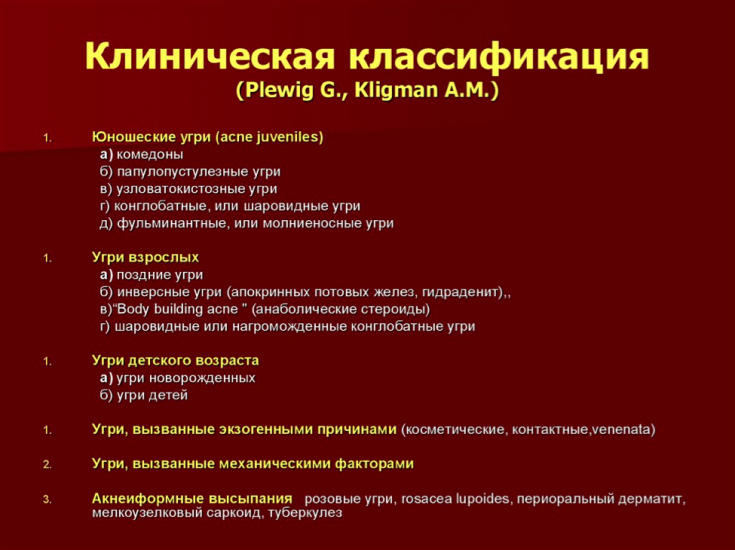Acne is one of the most common diseases. Almost 80% of people have had an episode of inflammatory rashes at least once in their lives. Typically, such phenomena occur in adolescents (70-80%), in almost 11% of the adult population after 25 years, and last an average of 4-5 years. In some cases, episodes of the disease last up to 10-12, and sometimes up to 50 years, passing from adolescence to adulthood, which is accompanied by severe inflammation, the formation of cysts and nodes, and subsequently - scarring.
The article on estet-portal.com presents the results of randomized controlled clinical trials for the treatment of acne with the use of systemic isotretinoin (IT), in particular, the short-term and long-term therapeutic effects of various regimens and regimens of therapy, as well as ways to minimize side effects.
- acne and post-acne in the practice of a dermatologist
- systemic retinoids in acne regimen
- isotrerionin doses as systemic acne therapy
Acne and post-acne in the practice of a dermatologist
Acne is included in a large category of infections of the skin and subcutaneous fat, and this group of diseases now ranks first in the structure of all dermatological pathology.
Follow us on Instagram!
Acne treatment today is an urgent social task due to facial lesions, the formation of post-inflammatory manifestations (dyschromia, cicatricial changes), the ineffectiveness of previous therapy, which is often accompanied by expressive psychosocial maladjustment, even in mild forms of dermatosis. Thus, the timely choice of effective therapy is an important and main task for a dermatologist in managing patients with acne of any severity.
Read also: Atopic dermatitis and psoriasis: how to correctly diagnose the disease
Treatment regimens, according to European, American protocols, contain recommendations for the use of systemic and topical retinoids, systemic and topical antibiotics, antiandrogens, as well as combined preparations for external use.
Systemic retinoids in the acne regimen
According to the data of the world scientific literature, today the only systemic drug that acts on all stages of acne pathogenesis is isotretinoin, which belongs to the group of monoaromatic retinoids. It was first approved for the treatment of acne by the US Food and Drug Administration (FDA) in 1982.

Since 2001, the production of generic isotretinoin has begun. At the same time, according to a study by scientists (European Dermatology Forum, 2016), retinoids are recommended as the first line of treatment for acne.
For more than 30 years, isotretinoin has been an effective medication for the treatment of acne.
This drug affects all the main etiopathogenetic factors of dermatosis: primarily - on the synthesis of sebum and pathological follicular hyperkeratosis, secondarily - on the colonization of Propionbacterium acnes, the formation of comedones and inflammatory chemotaxis of neutrophils.
Follow our updates on Facebook!
Isotretinoin is recognized as the only drug that promotes long-term remission in 70-80% of patients and gives a positive effect of almost 100%. With the discovery of nuclear receptors for retinoic acid, an era began to study the molecular mechanisms of action of retinoids. It has been proven that the diversity of biological effects of retinoids is a consequence of their powerful effect on DNA transcription.
Read also: What do skin rashes look like in diabetes
In the early 1980s, oral isotreninoin was used to treat severe nodular cystic acne, but indications for its use have expanded significantly in recent years. Since the beginning of the 1990s, dermatologists around the world have been actively using IT for moderately pronounced and even mild forms of acne, and also acne resistant to standard treatments, as well as with a tendency to scarring in a low and medium dose regimen (no more 0.5 mg / kg / day). As accumulated clinical experience of almost 30 years shows, this minimizes unwanted side effects and is a definite confirmation that often the benefits obtained from the use of the drug are much higher than possible risk of side effects.
Doses of isotretinoin as a systemic treatment for acne
According to the instructions for the drug, standard acne treatment regimens provide for the appointment of isotretinoin at a dose of 0.5-1.0 mg / kg / day, depending on the severity of the disease, while achieving a total cumulative dose of 120-150 mg / kg provides a stable therapeutic effect.

A number of dermatologists believe that systemic retinoids in a standard dose regimen are indicated in the case of:
a) severe acne;
b) less than 50% improvement after 6 months of standard therapy with antibiotics and external agents;
c) acne with complications in the form of scars;
d) acne with concomitant psychological disorders;
e) acne recurrence.
Read also: Oily skin: pathogenic factors and the main causes of this problem
The optimal dose is 0.5-0.75 mg/kg, which provides a quick therapeutic effect with minimal side effects. The duration of IT treatment in the standard dose regimen is set individually, but usually it is 5-8 months when the total course dose is reached.
More useful information on our YouTube-channel:







Add a comment